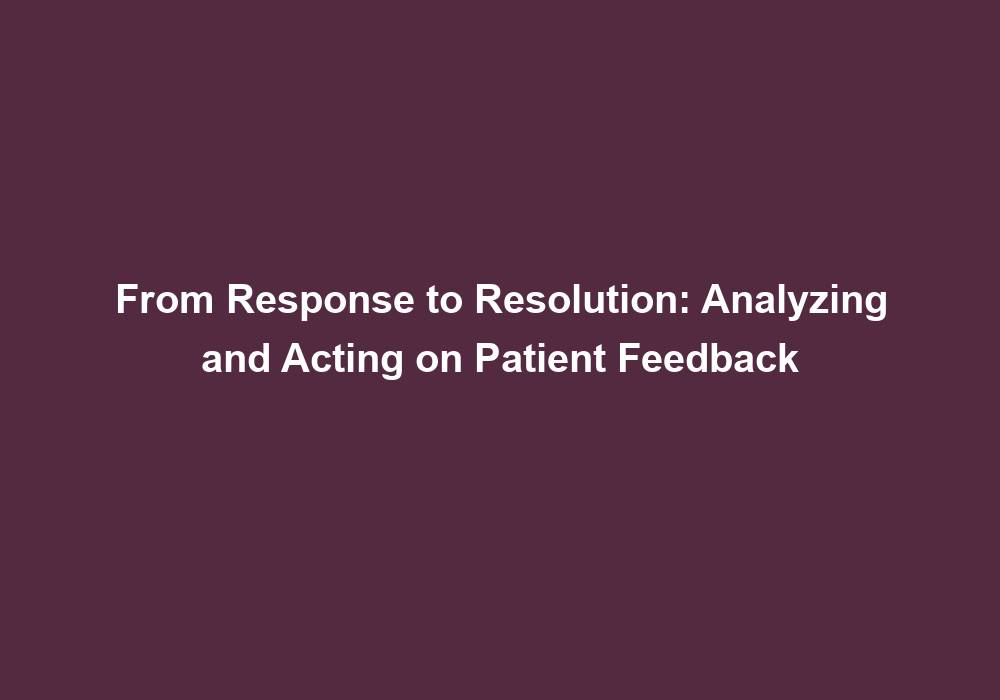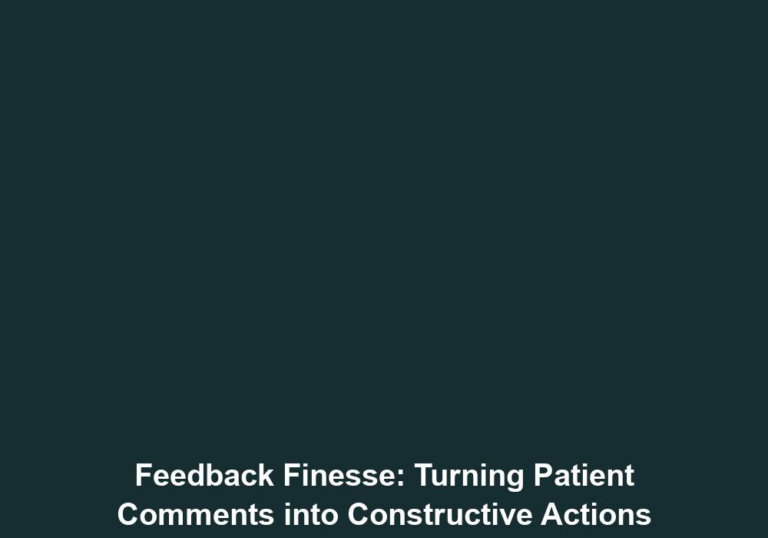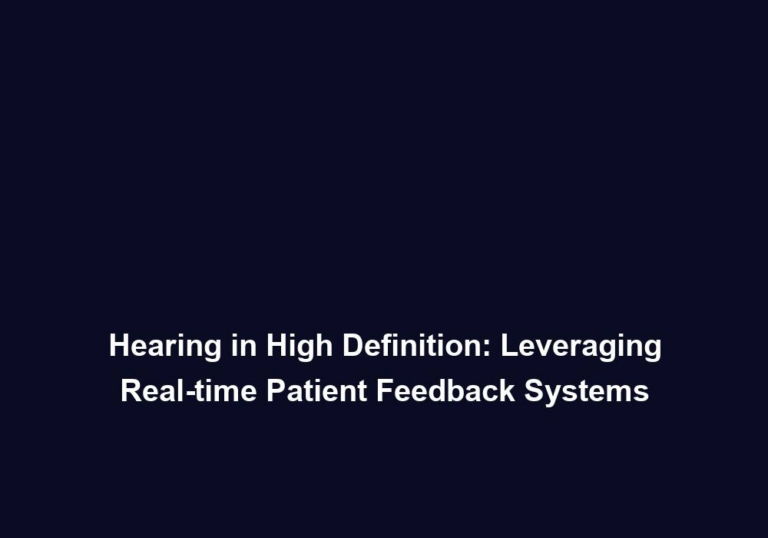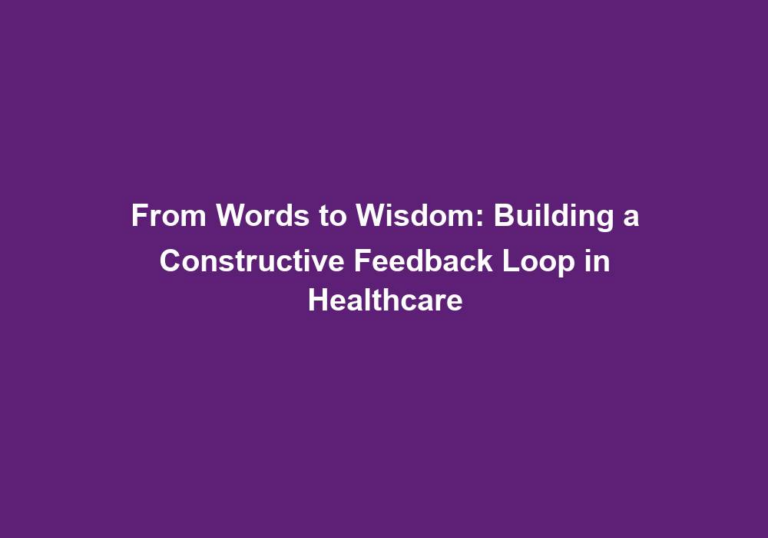From Response to Resolution: Analyzing and Acting on Patient Feedback
In the ever-evolving healthcare landscape, patient feedback plays a vital role in improving the quality of care and enhancing patient satisfaction. Understanding how to effectively analyze and act on patient feedback can enable healthcare providers to address concerns, identify areas of improvement, and ultimately deliver a higher standard of care. This article will delve into the significance of patient feedback, explore strategies for analyzing feedback, and discuss the actionable steps to resolve any issues identified.
The Importance of Patient Feedback
Patient feedback serves as a valuable resource for healthcare providers to assess the quality of their services and identify potential areas of improvement. By listening to patients’ concerns, suggestions, and experiences, healthcare organizations can gain valuable insights into their strengths and weaknesses. Here are a few reasons why patient feedback holds immense importance:
-
Enhancing Patient Satisfaction: Patient feedback sheds light on the overall patient experience, allowing healthcare providers to identify and address any gaps. By understanding patient expectations, healthcare providers can work towards exceeding them, leading to increased patient satisfaction.
-
Identifying Systemic Issues: Patient feedback helps in identifying recurring issues, bottlenecks, or inefficiencies within the healthcare system. By pinpointing these issues, healthcare providers can implement targeted improvements to enhance overall efficiency and effectiveness. For example, if multiple patients consistently express dissatisfaction with long waiting times in the emergency department, the healthcare provider can allocate more resources or streamline processes to reduce wait times and improve patient flow.
-
Building Patient Trust: By actively listening and responding to patient feedback, healthcare providers demonstrate their commitment to patient-centered care. This fosters trust, loyalty, and strengthens the patient-provider relationship. When patients see that their concerns are being acknowledged and addressed, they feel valued and more confident in the care they receive.
Strategies for Analyzing Patient Feedback
To effectively analyze patient feedback, healthcare providers need robust strategies in place. Here are some key strategies to consider:
1. Collect Feedback through Multiple Channels
Healthcare providers should adopt a multi-channel approach to collect patient feedback. This can include in-person surveys, online surveys, feedback forms on the website, social media listening, and patient satisfaction questionnaires. By diversifying feedback collection methods, healthcare providers can gather a more comprehensive and representative set of data. Each channel may capture different types of feedback and reach different patient demographics, providing a more holistic view of the patient experience.
2. Categorize and Prioritize Feedback
Once the feedback is collected, it is crucial to categorize and prioritize it based on various factors such as the severity of the issue, frequency of occurrence, and impact on the patient experience. This step helps in identifying the most critical areas that require immediate attention. Categorizing feedback into themes or topics can also facilitate the identification of common trends or patterns that may exist across different patient experiences.
3. Utilize Data Analytics Tools
Leveraging data analytics tools can streamline the analysis of patient feedback. These tools can help identify trends, patterns, and correlations in the feedback data, providing valuable insights. By utilizing data analytics, healthcare providers can make data-driven decisions and prioritize areas for improvement. For example, sentiment analysis tools can analyze the sentiment behind patient feedback, allowing providers to gauge overall satisfaction levels and identify specific areas where improvements are needed.
4. Engage in Sentiment Analysis
Sentiment analysis is a powerful technique that allows healthcare providers to gauge patient emotions and attitudes towards their services. By analyzing the sentiment behind patient feedback, providers can understand the overall satisfaction levels and identify specific areas where improvements are needed. For instance, if sentiment analysis reveals that a significant number of patients express frustration or disappointment with the appointment scheduling process, the healthcare provider can focus on streamlining the scheduling system to improve patient experience and reduce dissatisfaction.
5. Seek Professional Assistance
In some cases, healthcare providers may benefit from enlisting the help of professional consultants or agencies specializing in patient feedback analysis. These experts can provide valuable expertise, tools, and methodologies to extract meaningful insights from the feedback data. They can assist in identifying blind spots, uncovering hidden patterns, and offering recommendations for improvement. Professional assistance can help healthcare providers gain a fresh perspective and optimize their feedback analysis processes.
Acting on Patient Feedback: Steps towards Resolution
After analyzing patient feedback, the next crucial step is to take action and resolve any issues or concerns identified. Here are some actionable steps to guide healthcare providers towards resolution:
1. Address Immediate Concerns
If patient feedback highlights urgent concerns or issues that require immediate attention, healthcare providers should take swift action. This may involve reaching out to the patient directly, offering apologies or explanations, and implementing measures to rectify the situation promptly. By addressing immediate concerns, healthcare providers demonstrate their commitment to patient satisfaction and show that patient feedback is taken seriously.
2. Communicate Findings Internally
Sharing the analyzed feedback data with relevant stakeholders within the organization is crucial for fostering a culture of continuous improvement. By communicating the findings, healthcare providers can ensure that all team members are aware of the areas that require attention and collaboration. This promotes transparency and encourages a collective effort to address identified issues. Regular meetings or reports can be used to disseminate the feedback findings and discuss strategies for improvement.
3. Develop Action Plans
Based on the analysis of patient feedback, healthcare providers should develop action plans that outline specific steps to address the identified issues. These action plans should be SMART (Specific, Measurable, Achievable, Relevant, and Time-bound) and involve all relevant departments and personnel. Assigning responsibilities, setting deadlines, and defining key performance indicators (KPIs) can help ensure accountability and track progress towards resolution.
4. Continuous Monitoring and Evaluation
Monitoring and evaluating the impact of the implemented actions is vital to ensure sustained improvement. Healthcare providers should establish mechanisms to track progress, gather new feedback, and make adjustments as necessary. This cycle of continuous improvement helps in delivering long-term resolutions. Regularly reviewing feedback data, monitoring KPIs, and conducting follow-up surveys can provide insights into the effectiveness of the implemented actions and identify areas that may require further attention.
5. Share Outcomes with Patients
Lastly, healthcare providers should close the feedback loop by sharing the outcomes of the improvements with patients. This can be done through regular updates on the organization’s website, newsletters, or even personalized messages. By demonstrating that patient feedback has been heard and acted upon, healthcare providers can further strengthen patient trust and satisfaction. Sharing success stories or testimonials from patients who have benefited from the improvements can also inspire confidence in the healthcare provider’s commitment to continuous improvement.
In conclusion, patient feedback is a valuable resource that holds immense potential for enhancing the quality of care and patient satisfaction. By implementing effective strategies for analyzing and acting on patient feedback, healthcare providers can identify areas of improvement, drive organizational change, and ultimately deliver a patient-centered healthcare experience. Empowering patients to share their experiences and actively incorporating their feedback is essential in shaping a future where healthcare continuously evolves to meet patients’ needs.






